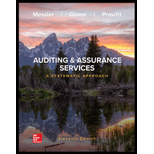
EBK AUDITING & ASSURANCE SERVICES: A SY
11th Edition
ISBN: 9781260687668
Author: Jr
Publisher: MCGRAW-HILL LEARNING SOLN.(CC)
expand_more
expand_more
format_list_bulleted
Question
Chapter 21, Problem 21.22MCQ
To determine
Concept Introduction:
The financial statements to be reviewed by the accountant should be accompanied by a report stating various elements like title, addressee, introductory paragraph, management responsibility, result of engagement, and signature of accountant and date of accountant’s report.
To choose: The correct option for the financial statements reviewed by an accountant.
Expert Solution & Answer
Want to see the full answer?
Check out a sample textbook solution
Students have asked these similar questions
Please don't use hand rating
"Dividend paying stocks cannot be growth stocks" Do you agree or disagree? Discuss choosing two stocks to help justify your view.
"Dividend paying stocks cannot be growth stocks" Do you agree or disagree? Discuss choosing two stocks to help justify your view.
Chapter 21 Solutions
EBK AUDITING & ASSURANCE SERVICES: A SY
Ch. 21 - Prob. 21.1RQCh. 21 - Prob. 21.2RQCh. 21 - Prob. 21.3RQCh. 21 - Prob. 21.4RQCh. 21 - Prob. 21.5RQCh. 21 - Prob. 21.6RQCh. 21 - Prob. 21.7RQCh. 21 - Prob. 21.8RQCh. 21 - Prob. 21.9RQCh. 21 - Prob. 21.10RQ
Ch. 21 - Prob. 21.11RQCh. 21 - Prob. 21.12RQCh. 21 - Prob. 21.13RQCh. 21 - Prob. 21.14RQCh. 21 - Prob. 21.15MCQCh. 21 - Prob. 21.16MCQCh. 21 - Prob. 21.17MCQCh. 21 - Prob. 21.18MCQCh. 21 - Prob. 21.19MCQCh. 21 - Prob. 21.20MCQCh. 21 - Prob. 21.21MCQCh. 21 - Prob. 21.22MCQCh. 21 - Prob. 21.23MCQCh. 21 - Prob. 21.24MCQCh. 21 - Prob. 21.25MCQCh. 21 - Prob. 21.26MCQCh. 21 - Prob. 21.27MCQCh. 21 - Prob. 21.28MCQCh. 21 - Prob. 21.29MCQCh. 21 - Prob. 21.30PCh. 21 - Prob. 21.31PCh. 21 - Prob. 21.32PCh. 21 - Prob. 21.33PCh. 21 - Prob. 21.34PCh. 21 - Prob. 21.35P
Knowledge Booster
Similar questions
- A firm needs to raise $950,000 but will incur flotation costs of 5%. How much will it pay in flotation costs? Multiple choice question. $55,500 $50,000 $47,500 $55,000arrow_forwardWhile determining the appropriate discount rate, if a firm uses a weighted average cost of capital that is unique to a particular project, it is using the Blank______. Multiple choice question. pure play approach economic value added method subjective approach security market line approacharrow_forwardWhen a company's interest payment Blank______, the company's tax bill Blank______. Multiple choice question. stays the same; increases decreases; decreases increases; decreases increases; increasesarrow_forward
- For the calculation of equity weights, the Blank______ value is used. Multiple choice question. historical average book marketarrow_forwardA firm needs to raise $950,000 but will incur flotation costs of 5%. How much will it pay in flotation costs? Multiple choice question. $50,000 $55,000 $55,500 $47,500arrow_forwardQuestion Mode Multiple Choice Question The issuance costs of new securities are referred to as Blank______ costs. Multiple choice question. exorbitant flotation sunk reparationarrow_forward
- What will happen to a company's tax bill if interest expense is deducted? Multiple choice question. The company's tax bill will increase. The company's tax bill will decrease. The company's tax bill will not be affected. The company's tax bill for the next year will be affected.arrow_forwardThe total market value of a firm is calculated as Blank______. Multiple choice question. the number of shares times the average price the number of shares times the future price the number of shares times the share price the number of shares times the issue pricearrow_forwardAccording the to the Blank______ approach for project evaluation, all proposed projects are placed into several risk categories. Multiple choice question. pure play divisional WACC subjectivearrow_forward
- To invest in a project, a company needs $50 million. Given its flotation costs of 7%, how much does the company need to raise? Multiple choice question. $53.76 million $46.50 million $50.00 million $53.50 millionarrow_forwardWhile determining the appropriate discount rate, if a firm uses a weighted average cost of capital that is unique to a particular project, it is using the Blank______. Multiple choice question. economic value added method pure play approach subjective approach security market line approacharrow_forwardWhat are flotation costs? Multiple choice question. They are the costs incurred to issue new securities in the market. They are the costs incurred to insure the payment due to bondholders. They are the costs incurred to meet day to day expenses. They are the costs incurred to keep a project in the business.arrow_forward
arrow_back_ios
SEE MORE QUESTIONS
arrow_forward_ios
Recommended textbooks for you
 Auditing: A Risk Based-Approach to Conducting a Q...AccountingISBN:9781305080577Author:Karla M Johnstone, Audrey A. Gramling, Larry E. RittenbergPublisher:South-Western College Pub
Auditing: A Risk Based-Approach to Conducting a Q...AccountingISBN:9781305080577Author:Karla M Johnstone, Audrey A. Gramling, Larry E. RittenbergPublisher:South-Western College Pub Auditing: A Risk Based-Approach (MindTap Course L...AccountingISBN:9781337619455Author:Karla M Johnstone, Audrey A. Gramling, Larry E. RittenbergPublisher:Cengage Learning
Auditing: A Risk Based-Approach (MindTap Course L...AccountingISBN:9781337619455Author:Karla M Johnstone, Audrey A. Gramling, Larry E. RittenbergPublisher:Cengage Learning

Auditing: A Risk Based-Approach to Conducting a Q...
Accounting
ISBN:9781305080577
Author:Karla M Johnstone, Audrey A. Gramling, Larry E. Rittenberg
Publisher:South-Western College Pub


Auditing: A Risk Based-Approach (MindTap Course L...
Accounting
ISBN:9781337619455
Author:Karla M Johnstone, Audrey A. Gramling, Larry E. Rittenberg
Publisher:Cengage Learning